Psychological Contract and Motivation Theories in HRM - UGB162 Essay
VerifiedAdded on 2023/01/09
|12
|3944
|52
Essay
AI Summary
This essay delves into the critical concepts of psychological contracts and motivation theories within the realm of Human Resource Management (HRM). The first part of the essay defines psychological contracts, differentiating them from employment contracts and highlighting their significance in contemporary business environments. It explores the benefits of psychological contracts, such as improved employee performance, diversity management, innovation, and employee loyalty, while also addressing the potential negative impacts of contract violations. The second part focuses on content theories of motivation, specifically Maslow's Hierarchy of Needs and Herzberg's Two-Factor Theory. It examines how these theories explain employee motivation, emphasizing the importance of understanding and addressing employee needs to enhance productivity and performance. The essay provides a comprehensive analysis of these key HRM concepts, supported by relevant academic sources, offering valuable insights for students and professionals alike. The assignment includes an introduction, main body, and conclusion, adhering to essay format guidelines.
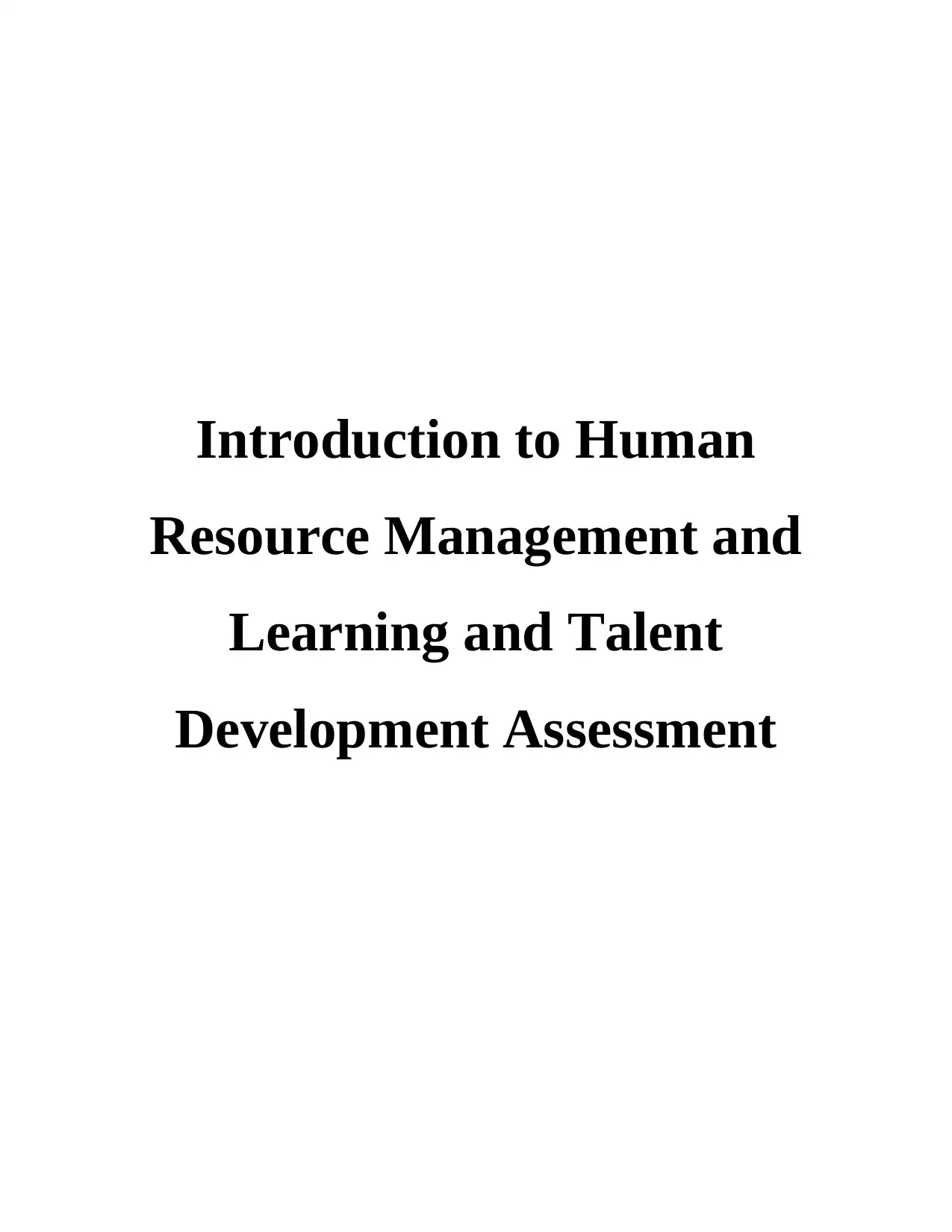
Introduction to Human
Resource Management and
Learning and Talent
Development Assessment
Resource Management and
Learning and Talent
Development Assessment
Paraphrase This Document
Need a fresh take? Get an instant paraphrase of this document with our AI Paraphraser

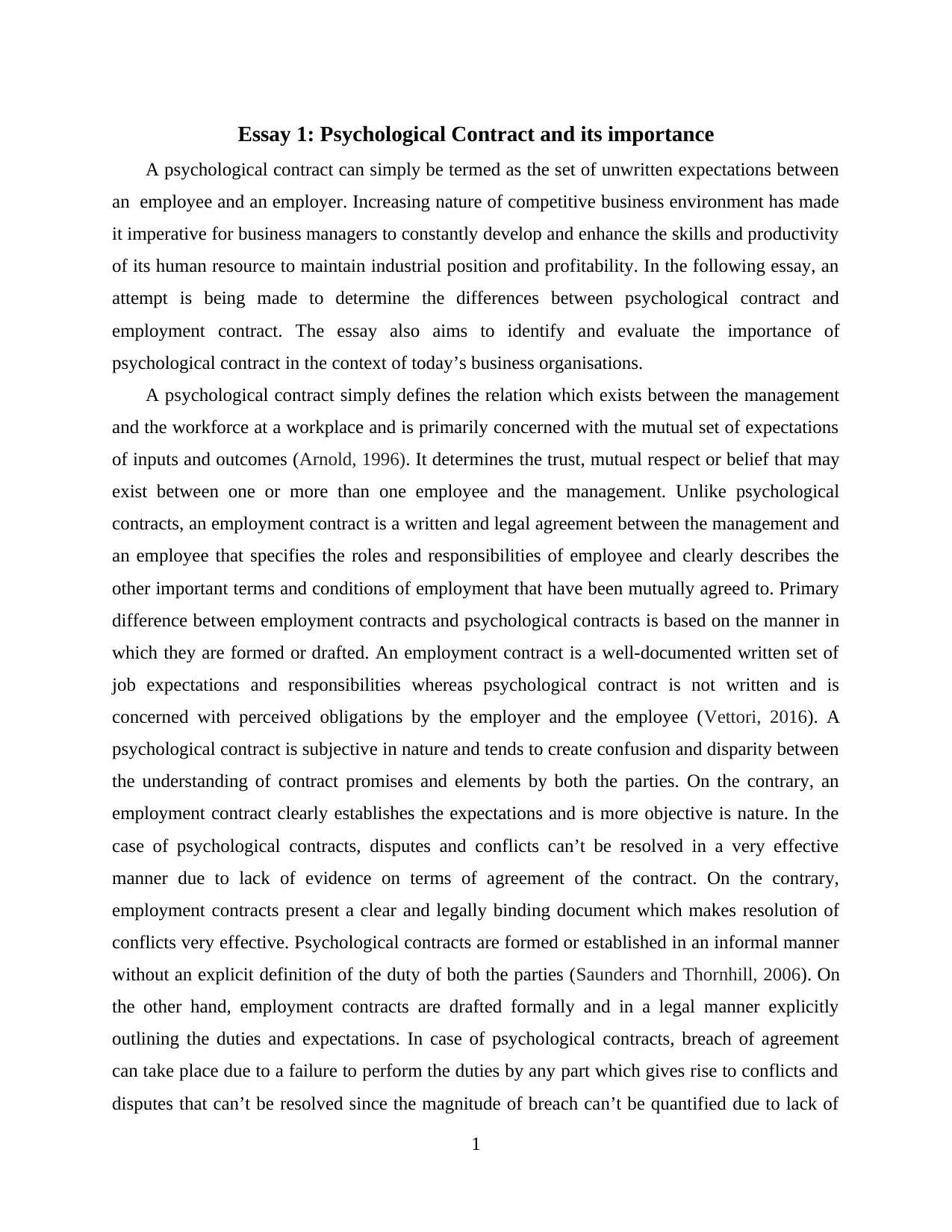
Essay 1: Psychological Contract and its importance
A psychological contract can simply be termed as the set of unwritten expectations between
an employee and an employer. Increasing nature of competitive business environment has made
it imperative for business managers to constantly develop and enhance the skills and productivity
of its human resource to maintain industrial position and profitability. In the following essay, an
attempt is being made to determine the differences between psychological contract and
employment contract. The essay also aims to identify and evaluate the importance of
psychological contract in the context of today’s business organisations.
A psychological contract simply defines the relation which exists between the management
and the workforce at a workplace and is primarily concerned with the mutual set of expectations
of inputs and outcomes (Arnold, 1996). It determines the trust, mutual respect or belief that may
exist between one or more than one employee and the management. Unlike psychological
contracts, an employment contract is a written and legal agreement between the management and
an employee that specifies the roles and responsibilities of employee and clearly describes the
other important terms and conditions of employment that have been mutually agreed to. Primary
difference between employment contracts and psychological contracts is based on the manner in
which they are formed or drafted. An employment contract is a well-documented written set of
job expectations and responsibilities whereas psychological contract is not written and is
concerned with perceived obligations by the employer and the employee (Vettori, 2016). A
psychological contract is subjective in nature and tends to create confusion and disparity between
the understanding of contract promises and elements by both the parties. On the contrary, an
employment contract clearly establishes the expectations and is more objective is nature. In the
case of psychological contracts, disputes and conflicts can’t be resolved in a very effective
manner due to lack of evidence on terms of agreement of the contract. On the contrary,
employment contracts present a clear and legally binding document which makes resolution of
conflicts very effective. Psychological contracts are formed or established in an informal manner
without an explicit definition of the duty of both the parties (Saunders and Thornhill, 2006). On
the other hand, employment contracts are drafted formally and in a legal manner explicitly
outlining the duties and expectations. In case of psychological contracts, breach of agreement
can take place due to a failure to perform the duties by any part which gives rise to conflicts and
disputes that can’t be resolved since the magnitude of breach can’t be quantified due to lack of
1
A psychological contract can simply be termed as the set of unwritten expectations between
an employee and an employer. Increasing nature of competitive business environment has made
it imperative for business managers to constantly develop and enhance the skills and productivity
of its human resource to maintain industrial position and profitability. In the following essay, an
attempt is being made to determine the differences between psychological contract and
employment contract. The essay also aims to identify and evaluate the importance of
psychological contract in the context of today’s business organisations.
A psychological contract simply defines the relation which exists between the management
and the workforce at a workplace and is primarily concerned with the mutual set of expectations
of inputs and outcomes (Arnold, 1996). It determines the trust, mutual respect or belief that may
exist between one or more than one employee and the management. Unlike psychological
contracts, an employment contract is a written and legal agreement between the management and
an employee that specifies the roles and responsibilities of employee and clearly describes the
other important terms and conditions of employment that have been mutually agreed to. Primary
difference between employment contracts and psychological contracts is based on the manner in
which they are formed or drafted. An employment contract is a well-documented written set of
job expectations and responsibilities whereas psychological contract is not written and is
concerned with perceived obligations by the employer and the employee (Vettori, 2016). A
psychological contract is subjective in nature and tends to create confusion and disparity between
the understanding of contract promises and elements by both the parties. On the contrary, an
employment contract clearly establishes the expectations and is more objective is nature. In the
case of psychological contracts, disputes and conflicts can’t be resolved in a very effective
manner due to lack of evidence on terms of agreement of the contract. On the contrary,
employment contracts present a clear and legally binding document which makes resolution of
conflicts very effective. Psychological contracts are formed or established in an informal manner
without an explicit definition of the duty of both the parties (Saunders and Thornhill, 2006). On
the other hand, employment contracts are drafted formally and in a legal manner explicitly
outlining the duties and expectations. In case of psychological contracts, breach of agreement
can take place due to a failure to perform the duties by any part which gives rise to conflicts and
disputes that can’t be resolved since the magnitude of breach can’t be quantified due to lack of
1
⊘ This is a preview!⊘
Do you want full access?
Subscribe today to unlock all pages.

Trusted by 1+ million students worldwide
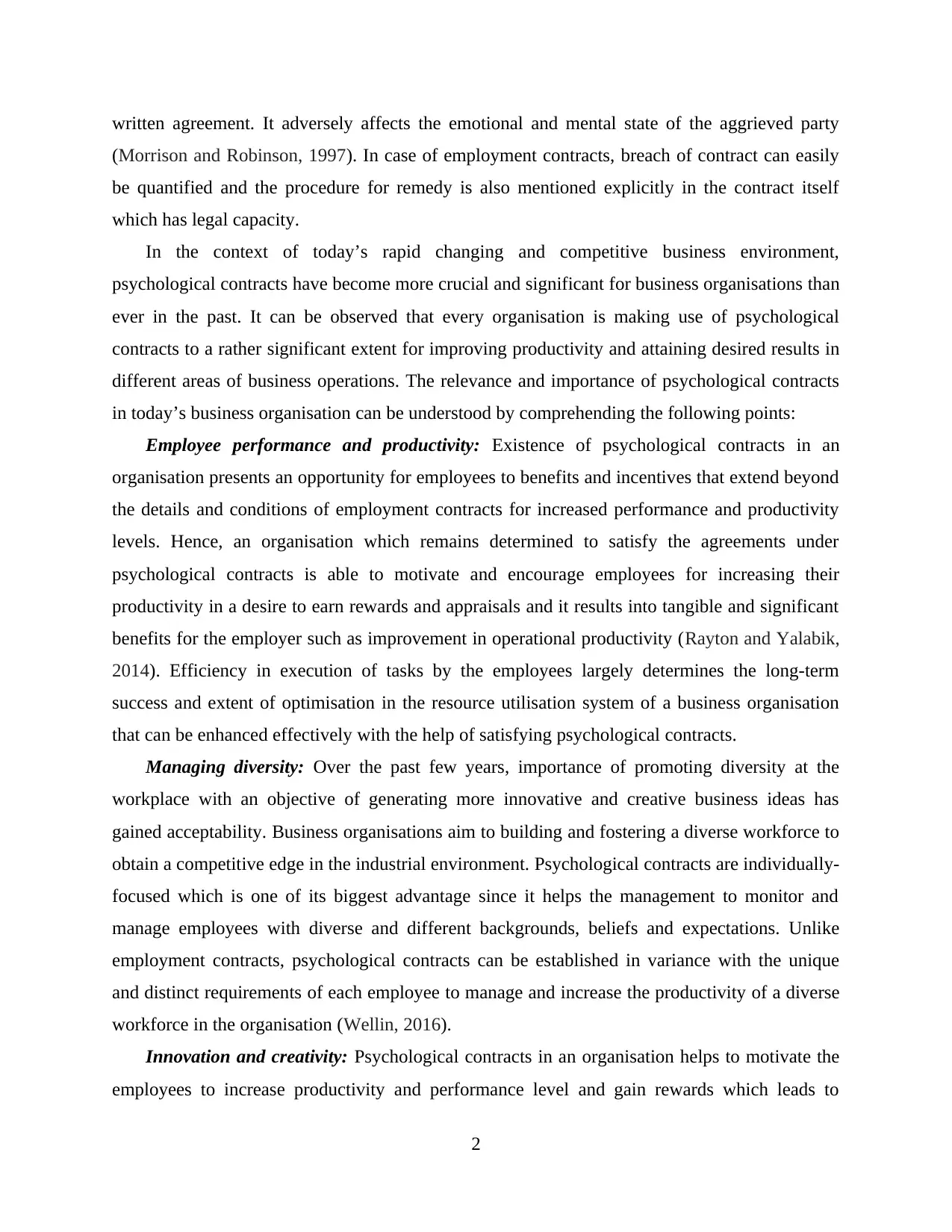
written agreement. It adversely affects the emotional and mental state of the aggrieved party
(Morrison and Robinson, 1997). In case of employment contracts, breach of contract can easily
be quantified and the procedure for remedy is also mentioned explicitly in the contract itself
which has legal capacity.
In the context of today’s rapid changing and competitive business environment,
psychological contracts have become more crucial and significant for business organisations than
ever in the past. It can be observed that every organisation is making use of psychological
contracts to a rather significant extent for improving productivity and attaining desired results in
different areas of business operations. The relevance and importance of psychological contracts
in today’s business organisation can be understood by comprehending the following points:
Employee performance and productivity: Existence of psychological contracts in an
organisation presents an opportunity for employees to benefits and incentives that extend beyond
the details and conditions of employment contracts for increased performance and productivity
levels. Hence, an organisation which remains determined to satisfy the agreements under
psychological contracts is able to motivate and encourage employees for increasing their
productivity in a desire to earn rewards and appraisals and it results into tangible and significant
benefits for the employer such as improvement in operational productivity (Rayton and Yalabik,
2014). Efficiency in execution of tasks by the employees largely determines the long-term
success and extent of optimisation in the resource utilisation system of a business organisation
that can be enhanced effectively with the help of satisfying psychological contracts.
Managing diversity: Over the past few years, importance of promoting diversity at the
workplace with an objective of generating more innovative and creative business ideas has
gained acceptability. Business organisations aim to building and fostering a diverse workforce to
obtain a competitive edge in the industrial environment. Psychological contracts are individually-
focused which is one of its biggest advantage since it helps the management to monitor and
manage employees with diverse and different backgrounds, beliefs and expectations. Unlike
employment contracts, psychological contracts can be established in variance with the unique
and distinct requirements of each employee to manage and increase the productivity of a diverse
workforce in the organisation (Wellin, 2016).
Innovation and creativity: Psychological contracts in an organisation helps to motivate the
employees to increase productivity and performance level and gain rewards which leads to
2
(Morrison and Robinson, 1997). In case of employment contracts, breach of contract can easily
be quantified and the procedure for remedy is also mentioned explicitly in the contract itself
which has legal capacity.
In the context of today’s rapid changing and competitive business environment,
psychological contracts have become more crucial and significant for business organisations than
ever in the past. It can be observed that every organisation is making use of psychological
contracts to a rather significant extent for improving productivity and attaining desired results in
different areas of business operations. The relevance and importance of psychological contracts
in today’s business organisation can be understood by comprehending the following points:
Employee performance and productivity: Existence of psychological contracts in an
organisation presents an opportunity for employees to benefits and incentives that extend beyond
the details and conditions of employment contracts for increased performance and productivity
levels. Hence, an organisation which remains determined to satisfy the agreements under
psychological contracts is able to motivate and encourage employees for increasing their
productivity in a desire to earn rewards and appraisals and it results into tangible and significant
benefits for the employer such as improvement in operational productivity (Rayton and Yalabik,
2014). Efficiency in execution of tasks by the employees largely determines the long-term
success and extent of optimisation in the resource utilisation system of a business organisation
that can be enhanced effectively with the help of satisfying psychological contracts.
Managing diversity: Over the past few years, importance of promoting diversity at the
workplace with an objective of generating more innovative and creative business ideas has
gained acceptability. Business organisations aim to building and fostering a diverse workforce to
obtain a competitive edge in the industrial environment. Psychological contracts are individually-
focused which is one of its biggest advantage since it helps the management to monitor and
manage employees with diverse and different backgrounds, beliefs and expectations. Unlike
employment contracts, psychological contracts can be established in variance with the unique
and distinct requirements of each employee to manage and increase the productivity of a diverse
workforce in the organisation (Wellin, 2016).
Innovation and creativity: Psychological contracts in an organisation helps to motivate the
employees to increase productivity and performance level and gain rewards which leads to
2
Paraphrase This Document
Need a fresh take? Get an instant paraphrase of this document with our AI Paraphraser
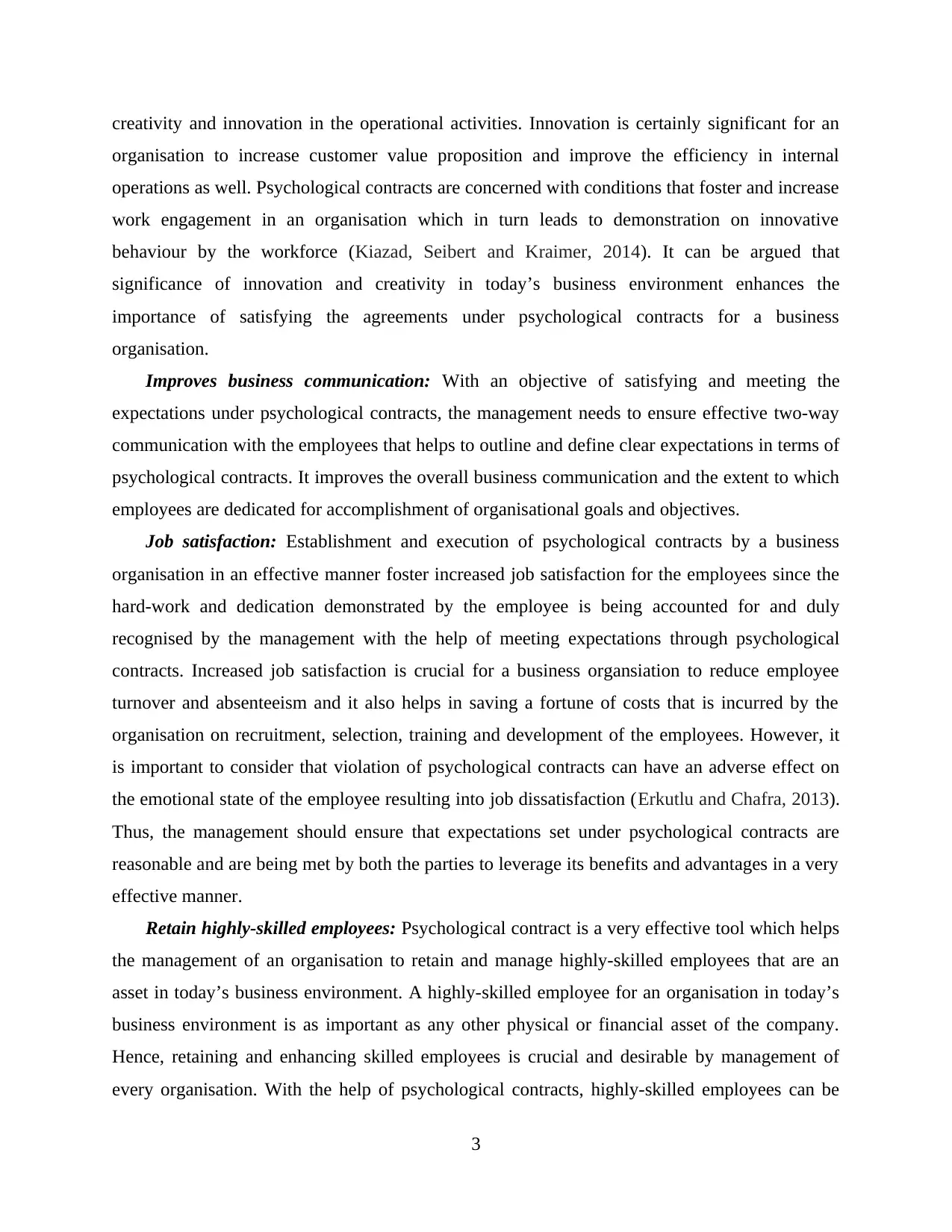
creativity and innovation in the operational activities. Innovation is certainly significant for an
organisation to increase customer value proposition and improve the efficiency in internal
operations as well. Psychological contracts are concerned with conditions that foster and increase
work engagement in an organisation which in turn leads to demonstration on innovative
behaviour by the workforce (Kiazad, Seibert and Kraimer, 2014). It can be argued that
significance of innovation and creativity in today’s business environment enhances the
importance of satisfying the agreements under psychological contracts for a business
organisation.
Improves business communication: With an objective of satisfying and meeting the
expectations under psychological contracts, the management needs to ensure effective two-way
communication with the employees that helps to outline and define clear expectations in terms of
psychological contracts. It improves the overall business communication and the extent to which
employees are dedicated for accomplishment of organisational goals and objectives.
Job satisfaction: Establishment and execution of psychological contracts by a business
organisation in an effective manner foster increased job satisfaction for the employees since the
hard-work and dedication demonstrated by the employee is being accounted for and duly
recognised by the management with the help of meeting expectations through psychological
contracts. Increased job satisfaction is crucial for a business organsiation to reduce employee
turnover and absenteeism and it also helps in saving a fortune of costs that is incurred by the
organisation on recruitment, selection, training and development of the employees. However, it
is important to consider that violation of psychological contracts can have an adverse effect on
the emotional state of the employee resulting into job dissatisfaction (Erkutlu and Chafra, 2013).
Thus, the management should ensure that expectations set under psychological contracts are
reasonable and are being met by both the parties to leverage its benefits and advantages in a very
effective manner.
Retain highly-skilled employees: Psychological contract is a very effective tool which helps
the management of an organisation to retain and manage highly-skilled employees that are an
asset in today’s business environment. A highly-skilled employee for an organisation in today’s
business environment is as important as any other physical or financial asset of the company.
Hence, retaining and enhancing skilled employees is crucial and desirable by management of
every organisation. With the help of psychological contracts, highly-skilled employees can be
3
organisation to increase customer value proposition and improve the efficiency in internal
operations as well. Psychological contracts are concerned with conditions that foster and increase
work engagement in an organisation which in turn leads to demonstration on innovative
behaviour by the workforce (Kiazad, Seibert and Kraimer, 2014). It can be argued that
significance of innovation and creativity in today’s business environment enhances the
importance of satisfying the agreements under psychological contracts for a business
organisation.
Improves business communication: With an objective of satisfying and meeting the
expectations under psychological contracts, the management needs to ensure effective two-way
communication with the employees that helps to outline and define clear expectations in terms of
psychological contracts. It improves the overall business communication and the extent to which
employees are dedicated for accomplishment of organisational goals and objectives.
Job satisfaction: Establishment and execution of psychological contracts by a business
organisation in an effective manner foster increased job satisfaction for the employees since the
hard-work and dedication demonstrated by the employee is being accounted for and duly
recognised by the management with the help of meeting expectations through psychological
contracts. Increased job satisfaction is crucial for a business organsiation to reduce employee
turnover and absenteeism and it also helps in saving a fortune of costs that is incurred by the
organisation on recruitment, selection, training and development of the employees. However, it
is important to consider that violation of psychological contracts can have an adverse effect on
the emotional state of the employee resulting into job dissatisfaction (Erkutlu and Chafra, 2013).
Thus, the management should ensure that expectations set under psychological contracts are
reasonable and are being met by both the parties to leverage its benefits and advantages in a very
effective manner.
Retain highly-skilled employees: Psychological contract is a very effective tool which helps
the management of an organisation to retain and manage highly-skilled employees that are an
asset in today’s business environment. A highly-skilled employee for an organisation in today’s
business environment is as important as any other physical or financial asset of the company.
Hence, retaining and enhancing skilled employees is crucial and desirable by management of
every organisation. With the help of psychological contracts, highly-skilled employees can be
3
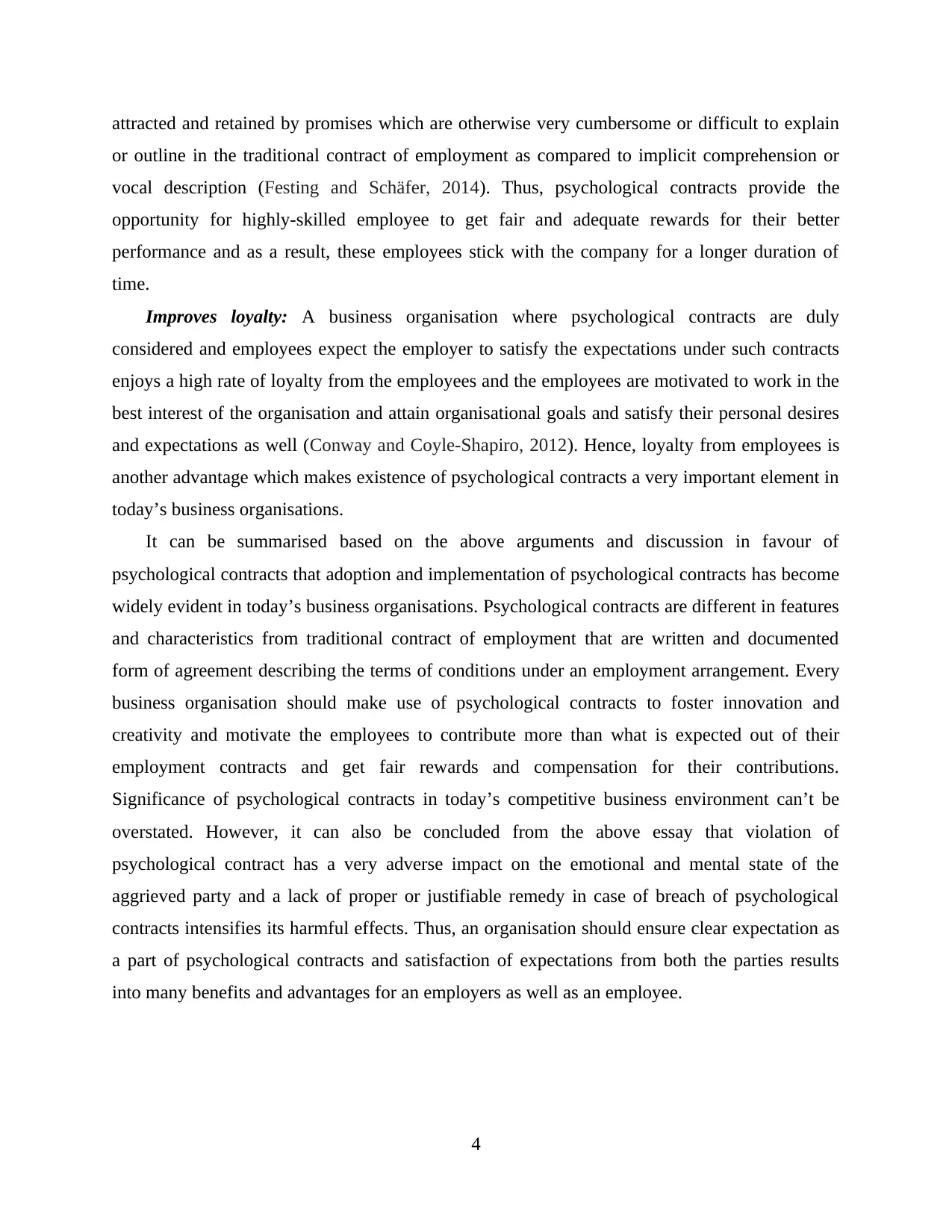
attracted and retained by promises which are otherwise very cumbersome or difficult to explain
or outline in the traditional contract of employment as compared to implicit comprehension or
vocal description (Festing and Schäfer, 2014). Thus, psychological contracts provide the
opportunity for highly-skilled employee to get fair and adequate rewards for their better
performance and as a result, these employees stick with the company for a longer duration of
time.
Improves loyalty: A business organisation where psychological contracts are duly
considered and employees expect the employer to satisfy the expectations under such contracts
enjoys a high rate of loyalty from the employees and the employees are motivated to work in the
best interest of the organisation and attain organisational goals and satisfy their personal desires
and expectations as well (Conway and Coyle‐Shapiro, 2012). Hence, loyalty from employees is
another advantage which makes existence of psychological contracts a very important element in
today’s business organisations.
It can be summarised based on the above arguments and discussion in favour of
psychological contracts that adoption and implementation of psychological contracts has become
widely evident in today’s business organisations. Psychological contracts are different in features
and characteristics from traditional contract of employment that are written and documented
form of agreement describing the terms of conditions under an employment arrangement. Every
business organisation should make use of psychological contracts to foster innovation and
creativity and motivate the employees to contribute more than what is expected out of their
employment contracts and get fair rewards and compensation for their contributions.
Significance of psychological contracts in today’s competitive business environment can’t be
overstated. However, it can also be concluded from the above essay that violation of
psychological contract has a very adverse impact on the emotional and mental state of the
aggrieved party and a lack of proper or justifiable remedy in case of breach of psychological
contracts intensifies its harmful effects. Thus, an organisation should ensure clear expectation as
a part of psychological contracts and satisfaction of expectations from both the parties results
into many benefits and advantages for an employers as well as an employee.
4
or outline in the traditional contract of employment as compared to implicit comprehension or
vocal description (Festing and Schäfer, 2014). Thus, psychological contracts provide the
opportunity for highly-skilled employee to get fair and adequate rewards for their better
performance and as a result, these employees stick with the company for a longer duration of
time.
Improves loyalty: A business organisation where psychological contracts are duly
considered and employees expect the employer to satisfy the expectations under such contracts
enjoys a high rate of loyalty from the employees and the employees are motivated to work in the
best interest of the organisation and attain organisational goals and satisfy their personal desires
and expectations as well (Conway and Coyle‐Shapiro, 2012). Hence, loyalty from employees is
another advantage which makes existence of psychological contracts a very important element in
today’s business organisations.
It can be summarised based on the above arguments and discussion in favour of
psychological contracts that adoption and implementation of psychological contracts has become
widely evident in today’s business organisations. Psychological contracts are different in features
and characteristics from traditional contract of employment that are written and documented
form of agreement describing the terms of conditions under an employment arrangement. Every
business organisation should make use of psychological contracts to foster innovation and
creativity and motivate the employees to contribute more than what is expected out of their
employment contracts and get fair rewards and compensation for their contributions.
Significance of psychological contracts in today’s competitive business environment can’t be
overstated. However, it can also be concluded from the above essay that violation of
psychological contract has a very adverse impact on the emotional and mental state of the
aggrieved party and a lack of proper or justifiable remedy in case of breach of psychological
contracts intensifies its harmful effects. Thus, an organisation should ensure clear expectation as
a part of psychological contracts and satisfaction of expectations from both the parties results
into many benefits and advantages for an employers as well as an employee.
4
⊘ This is a preview!⊘
Do you want full access?
Subscribe today to unlock all pages.

Trusted by 1+ million students worldwide
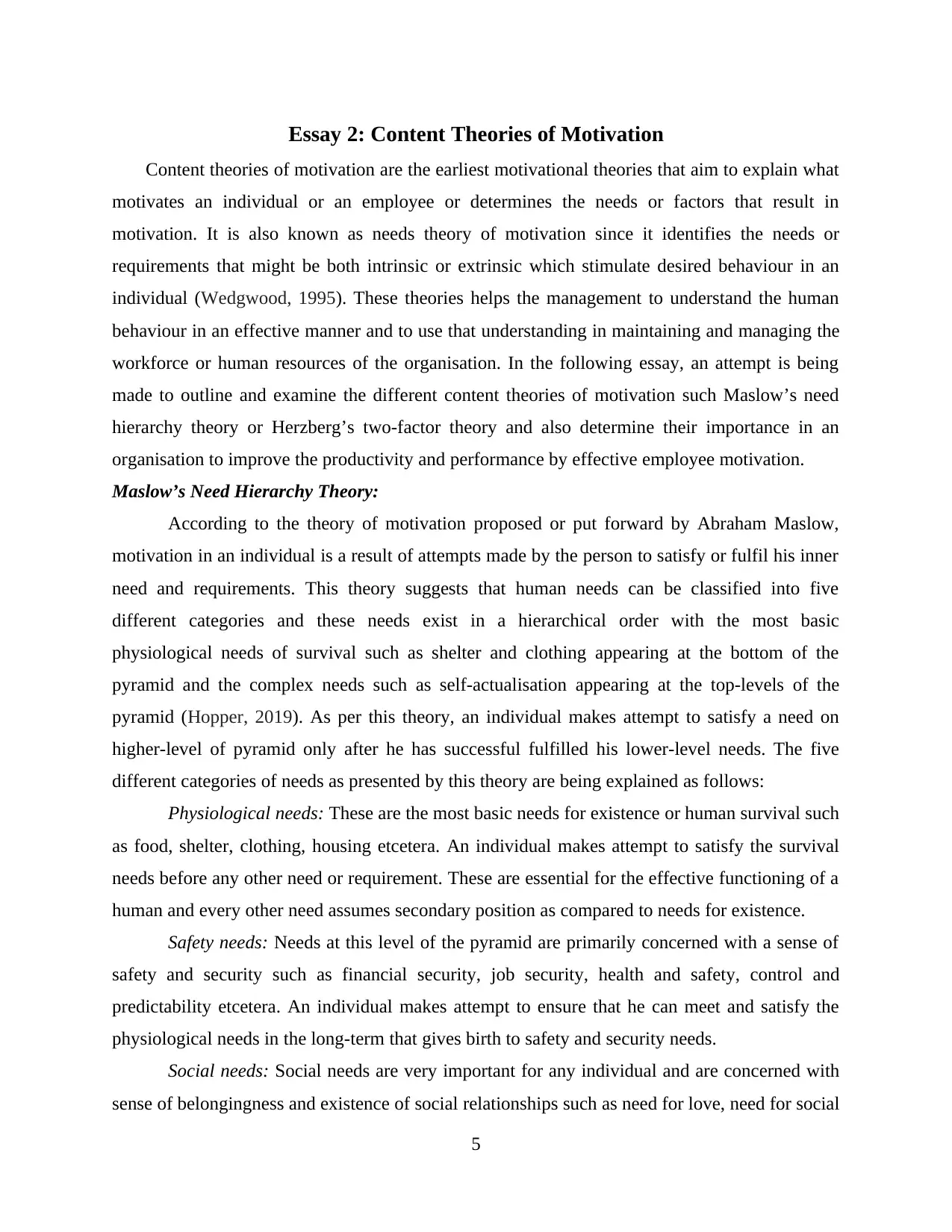
Essay 2: Content Theories of Motivation
Content theories of motivation are the earliest motivational theories that aim to explain what
motivates an individual or an employee or determines the needs or factors that result in
motivation. It is also known as needs theory of motivation since it identifies the needs or
requirements that might be both intrinsic or extrinsic which stimulate desired behaviour in an
individual (Wedgwood, 1995). These theories helps the management to understand the human
behaviour in an effective manner and to use that understanding in maintaining and managing the
workforce or human resources of the organisation. In the following essay, an attempt is being
made to outline and examine the different content theories of motivation such Maslow’s need
hierarchy theory or Herzberg’s two-factor theory and also determine their importance in an
organisation to improve the productivity and performance by effective employee motivation.
Maslow’s Need Hierarchy Theory:
According to the theory of motivation proposed or put forward by Abraham Maslow,
motivation in an individual is a result of attempts made by the person to satisfy or fulfil his inner
need and requirements. This theory suggests that human needs can be classified into five
different categories and these needs exist in a hierarchical order with the most basic
physiological needs of survival such as shelter and clothing appearing at the bottom of the
pyramid and the complex needs such as self-actualisation appearing at the top-levels of the
pyramid (Hopper, 2019). As per this theory, an individual makes attempt to satisfy a need on
higher-level of pyramid only after he has successful fulfilled his lower-level needs. The five
different categories of needs as presented by this theory are being explained as follows:
Physiological needs: These are the most basic needs for existence or human survival such
as food, shelter, clothing, housing etcetera. An individual makes attempt to satisfy the survival
needs before any other need or requirement. These are essential for the effective functioning of a
human and every other need assumes secondary position as compared to needs for existence.
Safety needs: Needs at this level of the pyramid are primarily concerned with a sense of
safety and security such as financial security, job security, health and safety, control and
predictability etcetera. An individual makes attempt to ensure that he can meet and satisfy the
physiological needs in the long-term that gives birth to safety and security needs.
Social needs: Social needs are very important for any individual and are concerned with
sense of belongingness and existence of social relationships such as need for love, need for social
5
Content theories of motivation are the earliest motivational theories that aim to explain what
motivates an individual or an employee or determines the needs or factors that result in
motivation. It is also known as needs theory of motivation since it identifies the needs or
requirements that might be both intrinsic or extrinsic which stimulate desired behaviour in an
individual (Wedgwood, 1995). These theories helps the management to understand the human
behaviour in an effective manner and to use that understanding in maintaining and managing the
workforce or human resources of the organisation. In the following essay, an attempt is being
made to outline and examine the different content theories of motivation such Maslow’s need
hierarchy theory or Herzberg’s two-factor theory and also determine their importance in an
organisation to improve the productivity and performance by effective employee motivation.
Maslow’s Need Hierarchy Theory:
According to the theory of motivation proposed or put forward by Abraham Maslow,
motivation in an individual is a result of attempts made by the person to satisfy or fulfil his inner
need and requirements. This theory suggests that human needs can be classified into five
different categories and these needs exist in a hierarchical order with the most basic
physiological needs of survival such as shelter and clothing appearing at the bottom of the
pyramid and the complex needs such as self-actualisation appearing at the top-levels of the
pyramid (Hopper, 2019). As per this theory, an individual makes attempt to satisfy a need on
higher-level of pyramid only after he has successful fulfilled his lower-level needs. The five
different categories of needs as presented by this theory are being explained as follows:
Physiological needs: These are the most basic needs for existence or human survival such
as food, shelter, clothing, housing etcetera. An individual makes attempt to satisfy the survival
needs before any other need or requirement. These are essential for the effective functioning of a
human and every other need assumes secondary position as compared to needs for existence.
Safety needs: Needs at this level of the pyramid are primarily concerned with a sense of
safety and security such as financial security, job security, health and safety, control and
predictability etcetera. An individual makes attempt to ensure that he can meet and satisfy the
physiological needs in the long-term that gives birth to safety and security needs.
Social needs: Social needs are very important for any individual and are concerned with
sense of belongingness and existence of social relationships such as need for love, need for social
5
Paraphrase This Document
Need a fresh take? Get an instant paraphrase of this document with our AI Paraphraser
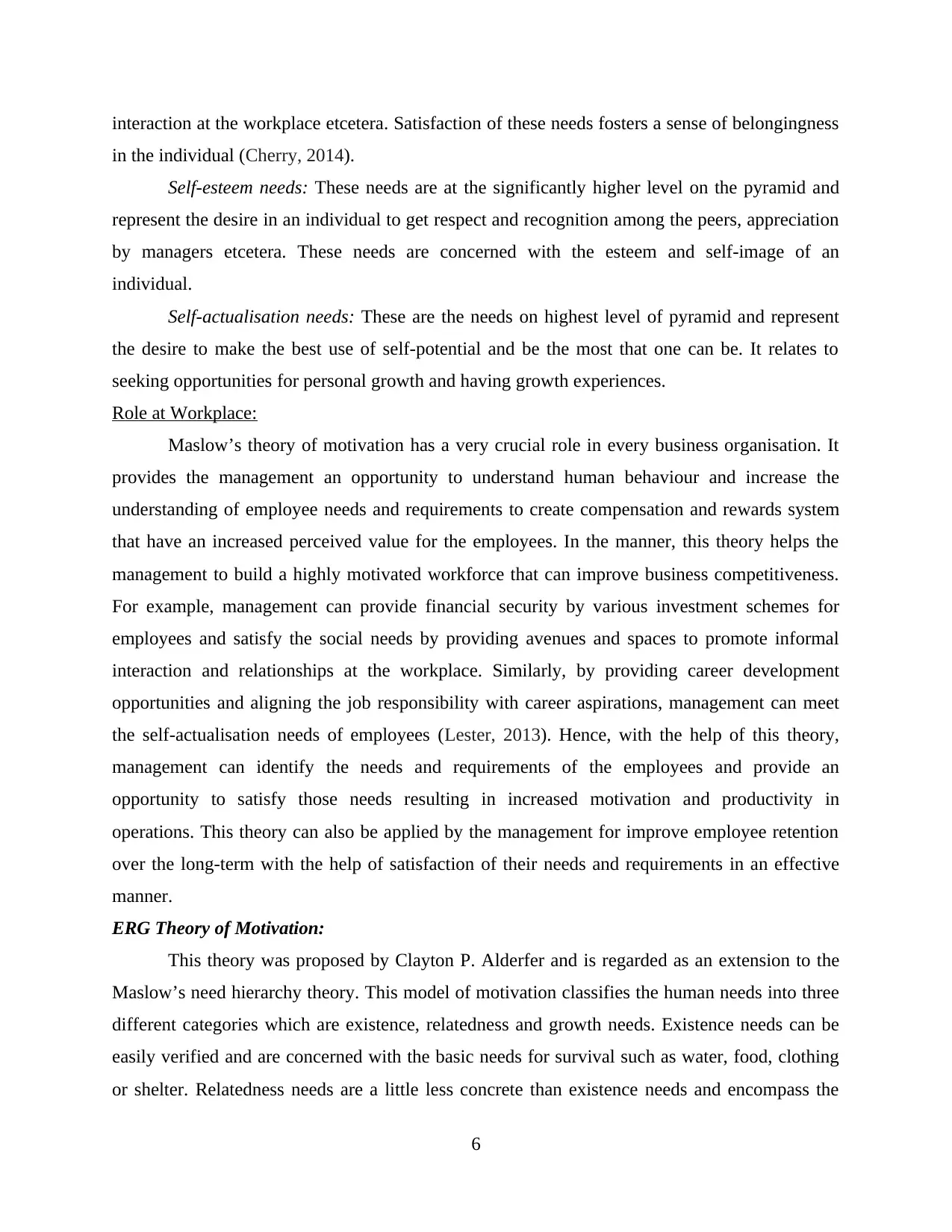
interaction at the workplace etcetera. Satisfaction of these needs fosters a sense of belongingness
in the individual (Cherry, 2014).
Self-esteem needs: These needs are at the significantly higher level on the pyramid and
represent the desire in an individual to get respect and recognition among the peers, appreciation
by managers etcetera. These needs are concerned with the esteem and self-image of an
individual.
Self-actualisation needs: These are the needs on highest level of pyramid and represent
the desire to make the best use of self-potential and be the most that one can be. It relates to
seeking opportunities for personal growth and having growth experiences.
Role at Workplace:
Maslow’s theory of motivation has a very crucial role in every business organisation. It
provides the management an opportunity to understand human behaviour and increase the
understanding of employee needs and requirements to create compensation and rewards system
that have an increased perceived value for the employees. In the manner, this theory helps the
management to build a highly motivated workforce that can improve business competitiveness.
For example, management can provide financial security by various investment schemes for
employees and satisfy the social needs by providing avenues and spaces to promote informal
interaction and relationships at the workplace. Similarly, by providing career development
opportunities and aligning the job responsibility with career aspirations, management can meet
the self-actualisation needs of employees (Lester, 2013). Hence, with the help of this theory,
management can identify the needs and requirements of the employees and provide an
opportunity to satisfy those needs resulting in increased motivation and productivity in
operations. This theory can also be applied by the management for improve employee retention
over the long-term with the help of satisfaction of their needs and requirements in an effective
manner.
ERG Theory of Motivation:
This theory was proposed by Clayton P. Alderfer and is regarded as an extension to the
Maslow’s need hierarchy theory. This model of motivation classifies the human needs into three
different categories which are existence, relatedness and growth needs. Existence needs can be
easily verified and are concerned with the basic needs for survival such as water, food, clothing
or shelter. Relatedness needs are a little less concrete than existence needs and encompass the
6
in the individual (Cherry, 2014).
Self-esteem needs: These needs are at the significantly higher level on the pyramid and
represent the desire in an individual to get respect and recognition among the peers, appreciation
by managers etcetera. These needs are concerned with the esteem and self-image of an
individual.
Self-actualisation needs: These are the needs on highest level of pyramid and represent
the desire to make the best use of self-potential and be the most that one can be. It relates to
seeking opportunities for personal growth and having growth experiences.
Role at Workplace:
Maslow’s theory of motivation has a very crucial role in every business organisation. It
provides the management an opportunity to understand human behaviour and increase the
understanding of employee needs and requirements to create compensation and rewards system
that have an increased perceived value for the employees. In the manner, this theory helps the
management to build a highly motivated workforce that can improve business competitiveness.
For example, management can provide financial security by various investment schemes for
employees and satisfy the social needs by providing avenues and spaces to promote informal
interaction and relationships at the workplace. Similarly, by providing career development
opportunities and aligning the job responsibility with career aspirations, management can meet
the self-actualisation needs of employees (Lester, 2013). Hence, with the help of this theory,
management can identify the needs and requirements of the employees and provide an
opportunity to satisfy those needs resulting in increased motivation and productivity in
operations. This theory can also be applied by the management for improve employee retention
over the long-term with the help of satisfaction of their needs and requirements in an effective
manner.
ERG Theory of Motivation:
This theory was proposed by Clayton P. Alderfer and is regarded as an extension to the
Maslow’s need hierarchy theory. This model of motivation classifies the human needs into three
different categories which are existence, relatedness and growth needs. Existence needs can be
easily verified and are concerned with the basic needs for survival such as water, food, clothing
or shelter. Relatedness needs are a little less concrete than existence needs and encompass the
6
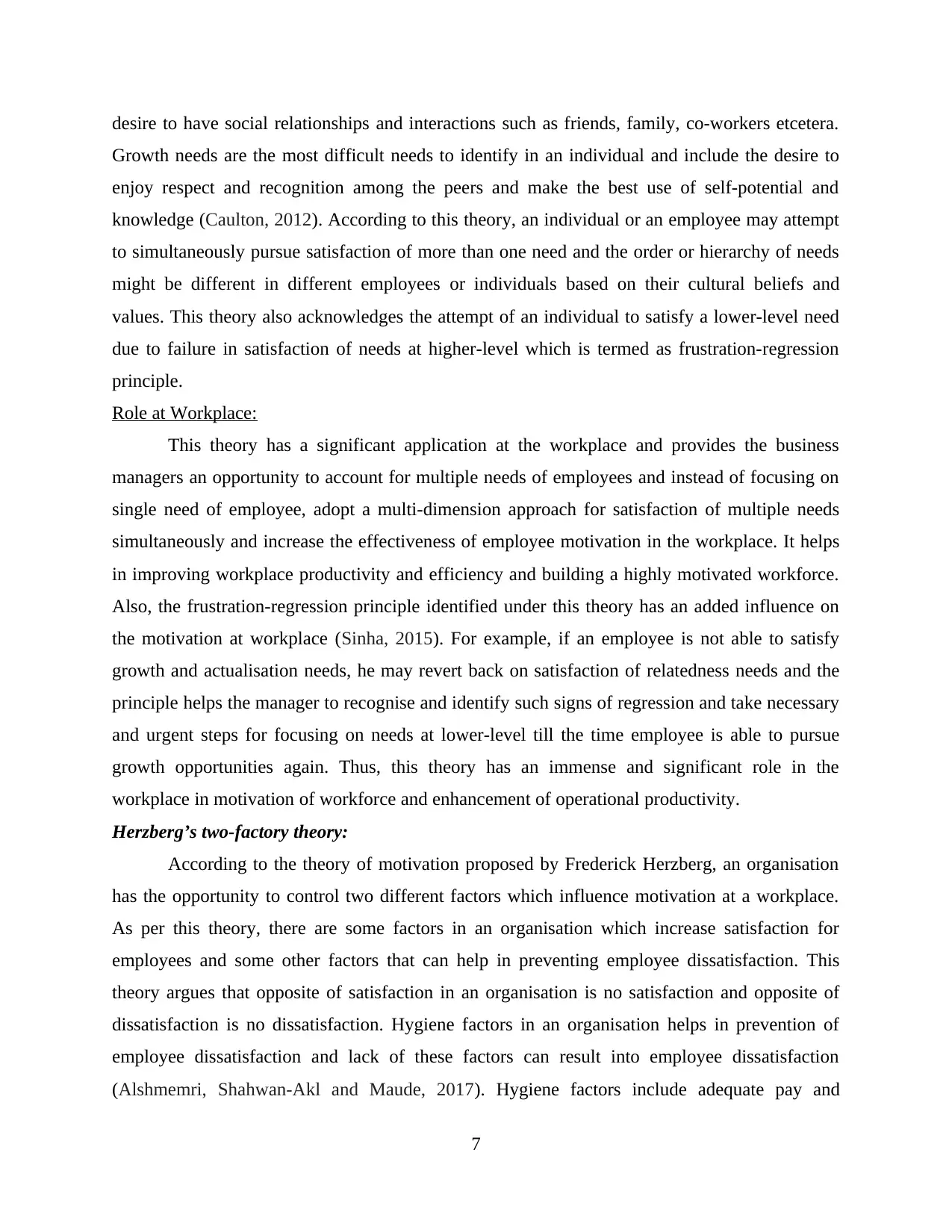
desire to have social relationships and interactions such as friends, family, co-workers etcetera.
Growth needs are the most difficult needs to identify in an individual and include the desire to
enjoy respect and recognition among the peers and make the best use of self-potential and
knowledge (Caulton, 2012). According to this theory, an individual or an employee may attempt
to simultaneously pursue satisfaction of more than one need and the order or hierarchy of needs
might be different in different employees or individuals based on their cultural beliefs and
values. This theory also acknowledges the attempt of an individual to satisfy a lower-level need
due to failure in satisfaction of needs at higher-level which is termed as frustration-regression
principle.
Role at Workplace:
This theory has a significant application at the workplace and provides the business
managers an opportunity to account for multiple needs of employees and instead of focusing on
single need of employee, adopt a multi-dimension approach for satisfaction of multiple needs
simultaneously and increase the effectiveness of employee motivation in the workplace. It helps
in improving workplace productivity and efficiency and building a highly motivated workforce.
Also, the frustration-regression principle identified under this theory has an added influence on
the motivation at workplace (Sinha, 2015). For example, if an employee is not able to satisfy
growth and actualisation needs, he may revert back on satisfaction of relatedness needs and the
principle helps the manager to recognise and identify such signs of regression and take necessary
and urgent steps for focusing on needs at lower-level till the time employee is able to pursue
growth opportunities again. Thus, this theory has an immense and significant role in the
workplace in motivation of workforce and enhancement of operational productivity.
Herzberg’s two-factory theory:
According to the theory of motivation proposed by Frederick Herzberg, an organisation
has the opportunity to control two different factors which influence motivation at a workplace.
As per this theory, there are some factors in an organisation which increase satisfaction for
employees and some other factors that can help in preventing employee dissatisfaction. This
theory argues that opposite of satisfaction in an organisation is no satisfaction and opposite of
dissatisfaction is no dissatisfaction. Hygiene factors in an organisation helps in prevention of
employee dissatisfaction and lack of these factors can result into employee dissatisfaction
(Alshmemri, Shahwan-Akl and Maude, 2017). Hygiene factors include adequate pay and
7
Growth needs are the most difficult needs to identify in an individual and include the desire to
enjoy respect and recognition among the peers and make the best use of self-potential and
knowledge (Caulton, 2012). According to this theory, an individual or an employee may attempt
to simultaneously pursue satisfaction of more than one need and the order or hierarchy of needs
might be different in different employees or individuals based on their cultural beliefs and
values. This theory also acknowledges the attempt of an individual to satisfy a lower-level need
due to failure in satisfaction of needs at higher-level which is termed as frustration-regression
principle.
Role at Workplace:
This theory has a significant application at the workplace and provides the business
managers an opportunity to account for multiple needs of employees and instead of focusing on
single need of employee, adopt a multi-dimension approach for satisfaction of multiple needs
simultaneously and increase the effectiveness of employee motivation in the workplace. It helps
in improving workplace productivity and efficiency and building a highly motivated workforce.
Also, the frustration-regression principle identified under this theory has an added influence on
the motivation at workplace (Sinha, 2015). For example, if an employee is not able to satisfy
growth and actualisation needs, he may revert back on satisfaction of relatedness needs and the
principle helps the manager to recognise and identify such signs of regression and take necessary
and urgent steps for focusing on needs at lower-level till the time employee is able to pursue
growth opportunities again. Thus, this theory has an immense and significant role in the
workplace in motivation of workforce and enhancement of operational productivity.
Herzberg’s two-factory theory:
According to the theory of motivation proposed by Frederick Herzberg, an organisation
has the opportunity to control two different factors which influence motivation at a workplace.
As per this theory, there are some factors in an organisation which increase satisfaction for
employees and some other factors that can help in preventing employee dissatisfaction. This
theory argues that opposite of satisfaction in an organisation is no satisfaction and opposite of
dissatisfaction is no dissatisfaction. Hygiene factors in an organisation helps in prevention of
employee dissatisfaction and lack of these factors can result into employee dissatisfaction
(Alshmemri, Shahwan-Akl and Maude, 2017). Hygiene factors include adequate pay and
7
⊘ This is a preview!⊘
Do you want full access?
Subscribe today to unlock all pages.

Trusted by 1+ million students worldwide
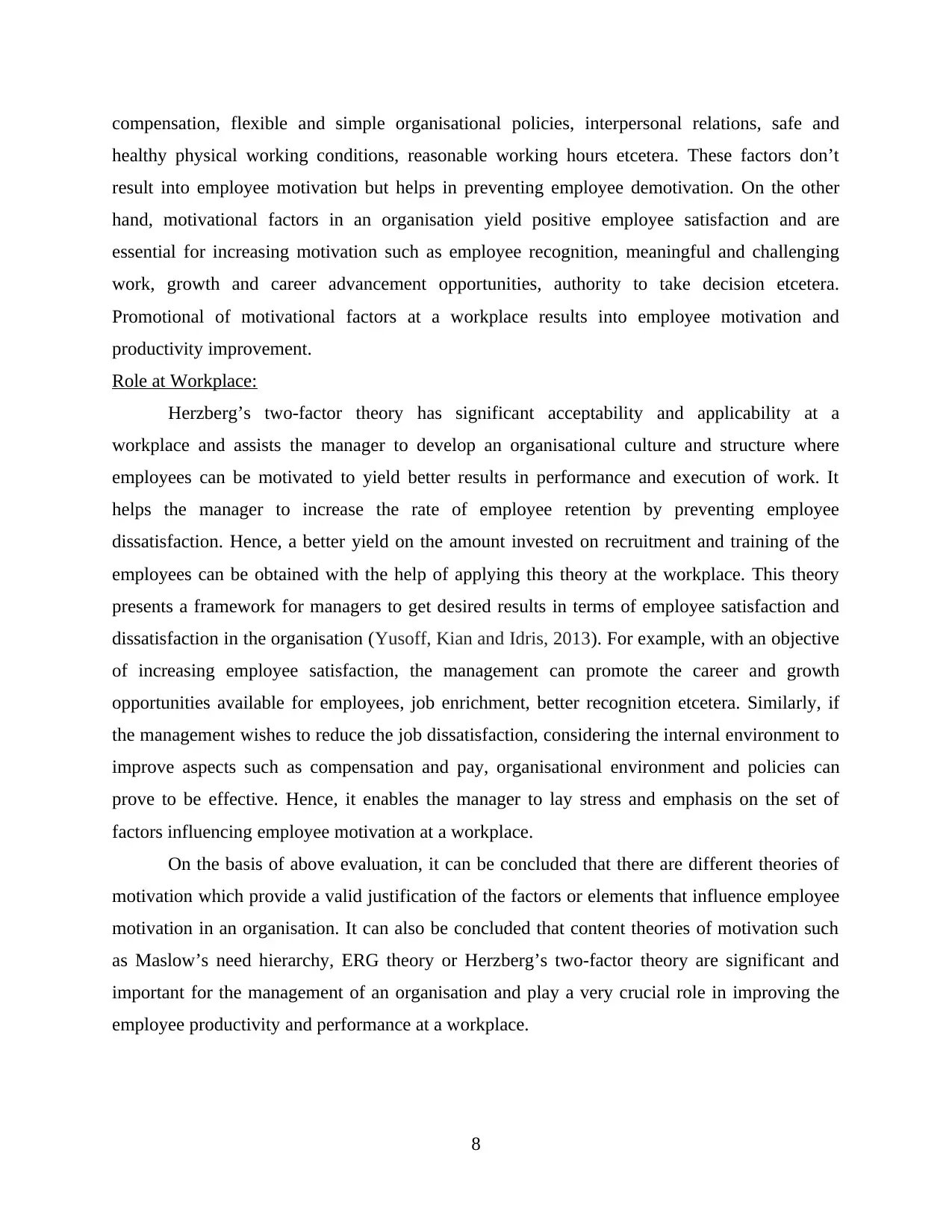
compensation, flexible and simple organisational policies, interpersonal relations, safe and
healthy physical working conditions, reasonable working hours etcetera. These factors don’t
result into employee motivation but helps in preventing employee demotivation. On the other
hand, motivational factors in an organisation yield positive employee satisfaction and are
essential for increasing motivation such as employee recognition, meaningful and challenging
work, growth and career advancement opportunities, authority to take decision etcetera.
Promotional of motivational factors at a workplace results into employee motivation and
productivity improvement.
Role at Workplace:
Herzberg’s two-factor theory has significant acceptability and applicability at a
workplace and assists the manager to develop an organisational culture and structure where
employees can be motivated to yield better results in performance and execution of work. It
helps the manager to increase the rate of employee retention by preventing employee
dissatisfaction. Hence, a better yield on the amount invested on recruitment and training of the
employees can be obtained with the help of applying this theory at the workplace. This theory
presents a framework for managers to get desired results in terms of employee satisfaction and
dissatisfaction in the organisation (Yusoff, Kian and Idris, 2013). For example, with an objective
of increasing employee satisfaction, the management can promote the career and growth
opportunities available for employees, job enrichment, better recognition etcetera. Similarly, if
the management wishes to reduce the job dissatisfaction, considering the internal environment to
improve aspects such as compensation and pay, organisational environment and policies can
prove to be effective. Hence, it enables the manager to lay stress and emphasis on the set of
factors influencing employee motivation at a workplace.
On the basis of above evaluation, it can be concluded that there are different theories of
motivation which provide a valid justification of the factors or elements that influence employee
motivation in an organisation. It can also be concluded that content theories of motivation such
as Maslow’s need hierarchy, ERG theory or Herzberg’s two-factor theory are significant and
important for the management of an organisation and play a very crucial role in improving the
employee productivity and performance at a workplace.
8
healthy physical working conditions, reasonable working hours etcetera. These factors don’t
result into employee motivation but helps in preventing employee demotivation. On the other
hand, motivational factors in an organisation yield positive employee satisfaction and are
essential for increasing motivation such as employee recognition, meaningful and challenging
work, growth and career advancement opportunities, authority to take decision etcetera.
Promotional of motivational factors at a workplace results into employee motivation and
productivity improvement.
Role at Workplace:
Herzberg’s two-factor theory has significant acceptability and applicability at a
workplace and assists the manager to develop an organisational culture and structure where
employees can be motivated to yield better results in performance and execution of work. It
helps the manager to increase the rate of employee retention by preventing employee
dissatisfaction. Hence, a better yield on the amount invested on recruitment and training of the
employees can be obtained with the help of applying this theory at the workplace. This theory
presents a framework for managers to get desired results in terms of employee satisfaction and
dissatisfaction in the organisation (Yusoff, Kian and Idris, 2013). For example, with an objective
of increasing employee satisfaction, the management can promote the career and growth
opportunities available for employees, job enrichment, better recognition etcetera. Similarly, if
the management wishes to reduce the job dissatisfaction, considering the internal environment to
improve aspects such as compensation and pay, organisational environment and policies can
prove to be effective. Hence, it enables the manager to lay stress and emphasis on the set of
factors influencing employee motivation at a workplace.
On the basis of above evaluation, it can be concluded that there are different theories of
motivation which provide a valid justification of the factors or elements that influence employee
motivation in an organisation. It can also be concluded that content theories of motivation such
as Maslow’s need hierarchy, ERG theory or Herzberg’s two-factor theory are significant and
important for the management of an organisation and play a very crucial role in improving the
employee productivity and performance at a workplace.
8
Paraphrase This Document
Need a fresh take? Get an instant paraphrase of this document with our AI Paraphraser
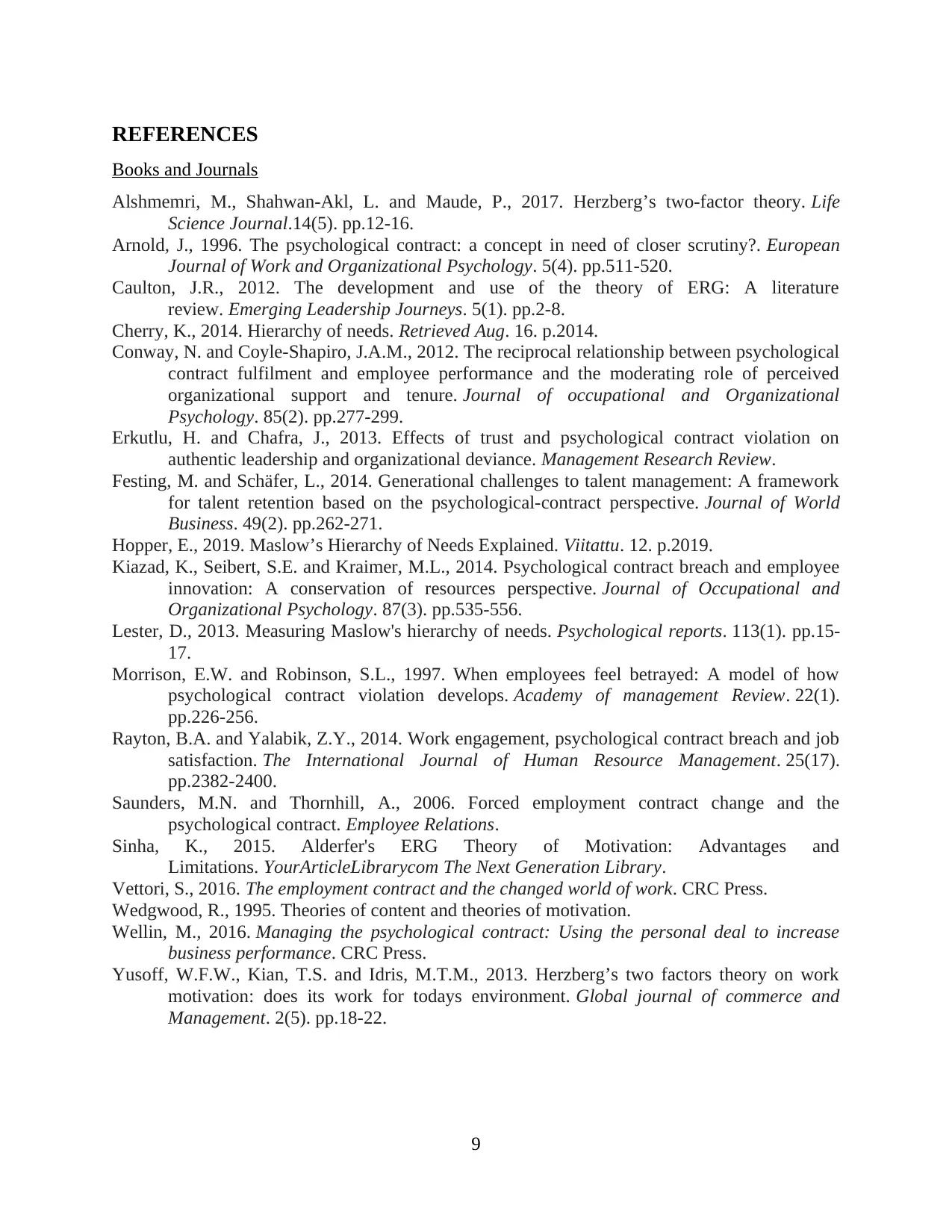
REFERENCES
Books and Journals
Alshmemri, M., Shahwan-Akl, L. and Maude, P., 2017. Herzberg’s two-factor theory. Life
Science Journal.14(5). pp.12-16.
Arnold, J., 1996. The psychological contract: a concept in need of closer scrutiny?. European
Journal of Work and Organizational Psychology. 5(4). pp.511-520.
Caulton, J.R., 2012. The development and use of the theory of ERG: A literature
review. Emerging Leadership Journeys. 5(1). pp.2-8.
Cherry, K., 2014. Hierarchy of needs. Retrieved Aug. 16. p.2014.
Conway, N. and Coyle‐Shapiro, J.A.M., 2012. The reciprocal relationship between psychological
contract fulfilment and employee performance and the moderating role of perceived
organizational support and tenure. Journal of occupational and Organizational
Psychology. 85(2). pp.277-299.
Erkutlu, H. and Chafra, J., 2013. Effects of trust and psychological contract violation on
authentic leadership and organizational deviance. Management Research Review.
Festing, M. and Schäfer, L., 2014. Generational challenges to talent management: A framework
for talent retention based on the psychological-contract perspective. Journal of World
Business. 49(2). pp.262-271.
Hopper, E., 2019. Maslow’s Hierarchy of Needs Explained. Viitattu. 12. p.2019.
Kiazad, K., Seibert, S.E. and Kraimer, M.L., 2014. Psychological contract breach and employee
innovation: A conservation of resources perspective. Journal of Occupational and
Organizational Psychology. 87(3). pp.535-556.
Lester, D., 2013. Measuring Maslow's hierarchy of needs. Psychological reports. 113(1). pp.15-
17.
Morrison, E.W. and Robinson, S.L., 1997. When employees feel betrayed: A model of how
psychological contract violation develops. Academy of management Review. 22(1).
pp.226-256.
Rayton, B.A. and Yalabik, Z.Y., 2014. Work engagement, psychological contract breach and job
satisfaction. The International Journal of Human Resource Management. 25(17).
pp.2382-2400.
Saunders, M.N. and Thornhill, A., 2006. Forced employment contract change and the
psychological contract. Employee Relations.
Sinha, K., 2015. Alderfer's ERG Theory of Motivation: Advantages and
Limitations. YourArticleLibrarycom The Next Generation Library.
Vettori, S., 2016. The employment contract and the changed world of work. CRC Press.
Wedgwood, R., 1995. Theories of content and theories of motivation.
Wellin, M., 2016. Managing the psychological contract: Using the personal deal to increase
business performance. CRC Press.
Yusoff, W.F.W., Kian, T.S. and Idris, M.T.M., 2013. Herzberg’s two factors theory on work
motivation: does its work for todays environment. Global journal of commerce and
Management. 2(5). pp.18-22.
9
Books and Journals
Alshmemri, M., Shahwan-Akl, L. and Maude, P., 2017. Herzberg’s two-factor theory. Life
Science Journal.14(5). pp.12-16.
Arnold, J., 1996. The psychological contract: a concept in need of closer scrutiny?. European
Journal of Work and Organizational Psychology. 5(4). pp.511-520.
Caulton, J.R., 2012. The development and use of the theory of ERG: A literature
review. Emerging Leadership Journeys. 5(1). pp.2-8.
Cherry, K., 2014. Hierarchy of needs. Retrieved Aug. 16. p.2014.
Conway, N. and Coyle‐Shapiro, J.A.M., 2012. The reciprocal relationship between psychological
contract fulfilment and employee performance and the moderating role of perceived
organizational support and tenure. Journal of occupational and Organizational
Psychology. 85(2). pp.277-299.
Erkutlu, H. and Chafra, J., 2013. Effects of trust and psychological contract violation on
authentic leadership and organizational deviance. Management Research Review.
Festing, M. and Schäfer, L., 2014. Generational challenges to talent management: A framework
for talent retention based on the psychological-contract perspective. Journal of World
Business. 49(2). pp.262-271.
Hopper, E., 2019. Maslow’s Hierarchy of Needs Explained. Viitattu. 12. p.2019.
Kiazad, K., Seibert, S.E. and Kraimer, M.L., 2014. Psychological contract breach and employee
innovation: A conservation of resources perspective. Journal of Occupational and
Organizational Psychology. 87(3). pp.535-556.
Lester, D., 2013. Measuring Maslow's hierarchy of needs. Psychological reports. 113(1). pp.15-
17.
Morrison, E.W. and Robinson, S.L., 1997. When employees feel betrayed: A model of how
psychological contract violation develops. Academy of management Review. 22(1).
pp.226-256.
Rayton, B.A. and Yalabik, Z.Y., 2014. Work engagement, psychological contract breach and job
satisfaction. The International Journal of Human Resource Management. 25(17).
pp.2382-2400.
Saunders, M.N. and Thornhill, A., 2006. Forced employment contract change and the
psychological contract. Employee Relations.
Sinha, K., 2015. Alderfer's ERG Theory of Motivation: Advantages and
Limitations. YourArticleLibrarycom The Next Generation Library.
Vettori, S., 2016. The employment contract and the changed world of work. CRC Press.
Wedgwood, R., 1995. Theories of content and theories of motivation.
Wellin, M., 2016. Managing the psychological contract: Using the personal deal to increase
business performance. CRC Press.
Yusoff, W.F.W., Kian, T.S. and Idris, M.T.M., 2013. Herzberg’s two factors theory on work
motivation: does its work for todays environment. Global journal of commerce and
Management. 2(5). pp.18-22.
9

10
⊘ This is a preview!⊘
Do you want full access?
Subscribe today to unlock all pages.

Trusted by 1+ million students worldwide
1 out of 12
Related Documents
Your All-in-One AI-Powered Toolkit for Academic Success.
+13062052269
info@desklib.com
Available 24*7 on WhatsApp / Email
![[object Object]](/_next/static/media/star-bottom.7253800d.svg)
Unlock your academic potential
Copyright © 2020–2025 A2Z Services. All Rights Reserved. Developed and managed by ZUCOL.





